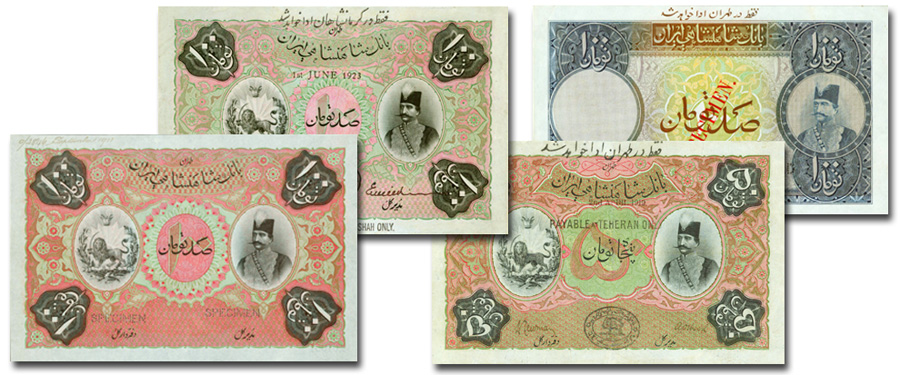
It may only be the end of August, but we have already began to put together an exceptional sale for what we anticipate will be our biggest World paper money auction in recent memory. Highlighting the auction so far is an exceptional collection of notes from The Imperial Bank of Persia belonging to Dr. Magid Alkimawi, a prominent collector of rare and exceptional banknotes. Dr. Alkimawi has spent a significant amount of money, time, and effort piecing together some of these very rare notes by way of multiple trips to the Middle East to meet with sellers in person.
The highlights of this collection that will be offered in our upcoming auction include two very rare issued notes: Pick 7, a 50 Tomans note Payable at Teheran, and Pick 8, a 100 Tomans note Payable at Kermanshah. Both notes are rare in any form, but they are exceptionally rare as issued notes. We have been unable to find any public auction records for either of these notes in issued form. These are the first we have handled and are likely to be the last for quite some time, possibly ever. Both notes have been certified by World Banknote Grading with the 50 Tomans being graded a 25 Qualified and the 100 Tomans receiving a 35 Qualified. These examples show extraordinary detail, have great registration, and retain their original color. Striking hand written signatures are present and bold overprints are also seen.
Also featured in Dr. Alkimawi’s collection are two additional rare specimen pieces. One of them is a Pick 8 100 Tomans in high grade Gem PMG 66 EPQ. The BWC design is as flawless and problem free as possible, with perforated specimen punched above each of the signature panels. A printer’s annotation dated September 1911 is in the top margin towards the left of center. The other specimen is Pick 17, the 100 Tomans example issued between 1924 and 1932. This BWC design has much bolder inks as the design technology had improved from the series prior. A diagonal red specimen overprint is seen at center. Cancelled is perforated above each of the signature panels. The bold ink colors are blue, brown, yellow, green, and a light violet. Minor handling has resulted in PMG grading the note Choice About Uncirculated 58. The back mentions that this particular specimen was designed with the Payable at Teheran overprint. This design is very pleasing and is one of the rarer specimens from this bank.
All of these notes feature vignettes of Nasr ad-Din Shah and the Lion and Sun motif holding Arms. The sun in the Lion and Sun motif is believed to resemble Mithra, the sun god in Zoroastrian beliefs. The lion is symbolic of virility and strength. This combination is deep rooted in Persian culture and is often associated with Royalty. The Qajar Dynasty made the Lion and Sun the official symbol of the royal house. Naser al-Din Shah was part of the Qajar dynasty. Even though he was assassinated in 1896, his portrait remained on these notes for more than 25 years after his death, and these Imperial notes are often referred to as Qajar notes.
Established in 1889, the Imperial Bank of Persia was Iran’s first attempt of establish a modern banking system. Seventeen years earlier, a baron named Julius de Reuter signed an agreement with the Iranian Government in Tehran that granted him permission to start a Bank or establishment of credit if the government ever decided to allow anyone to do so. Red tape and opposition by many different agencies caused this to take quite a bit of time. Eventually a royal charter was issued in September 1889 authorizing the establishment of the first bank but with many restrictions including a mandate that all branches be located within Iran, that the board of directors had to be in London and that more than 50% of the capital had to be issued in the United Kingdom. Ultimately this made the Imperial Bank of Persia an exclusively British bank even though Iran was not a British colony.
Reza Shah Pahlavi took control of the country when he was selected as Prime Minister of Iran in 1923. The desire for Iran to have full control of their banking system was the beginning of the end for the Imperial Bank of Persia. The bank’s ability to issue notes was taken away in 1932. Many of the notes were destroyed over time by the Imperial Bank of Persia. Of the issued notes sent into circulation, only 236 of the 50 Tomans, and 153 of the 100 Tomans remain that were not destroyed by the government; they survived because they were either stolen, or never returned to be destroyed. The last known accounting of these numbers was in 1931 so it is likely that those numbers have since decreased dramatically, and it is likely that just a handful or less survive.
These notes will be offered in the live session of our official January NYINC World Paper Money auction to be held at the Waldorf Astoria. We are currently accepting consignments for our 2016-2017 auction season. If you are interested in consigning or if you have a currency related question, please call 1-800-458-4646 or email Currency Specialist Aris Maragoudakis at [email protected] or Director of Currency Peter Treglia at [email protected].





